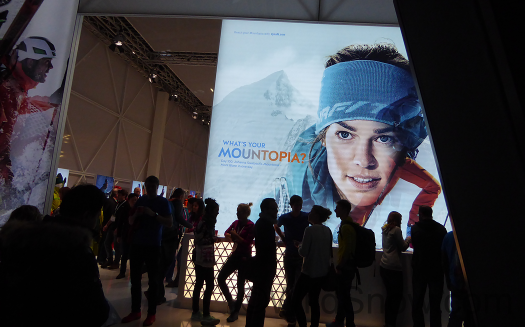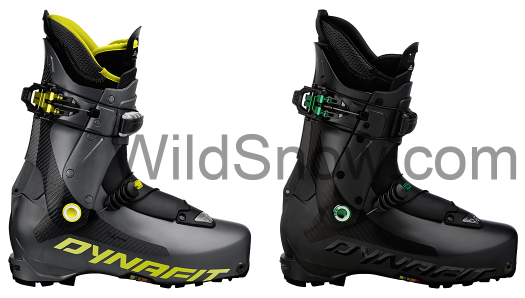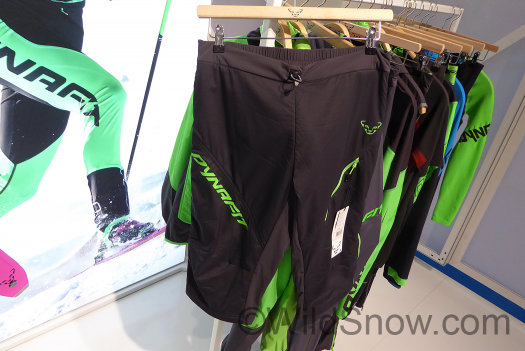At the Dynafit press events, a highlight for me (besides gulping PR Koolaid in indigenous forms such as schnapps or tsipouro) is always CEO Benedikt Böhm’s introductory presentation. Speaking rapidly in German accented but clear English, “Bene” usually gets into the state of the Snow Leopard by relating things beyond the press releases. He even shares a few secrets he swears us all to keep, at least until the ISPO trade show (or at least until a mouth breathing gear blogger steals Dynafit’s embargoed intellectual property and spills the beans in a desperate search for website traffic — as seems to happen frequently.)
This lengthy Dynafit post isn’t intended to be a screed from a fanboy. Rather, it’s me trying to distill a bunch of impressions over the past few years regarding what is still the only ski brand that’s 100% ski touring and boasts a full line from boots to clothing — a brand that many of us are yes, fans of. Yet a brand that seems to always be inventing itself (in a good way). Readers, your comments appreciated. What do you think of all the directions Dynafit has been heading over the past few years? What would you like to see them do?
I typed up this synopsis of his talk for you Dynafit brand fans out there, and dumped in some value-added rumors and factoids. The setting: A small hotel in the Greek mountains, as well as my travels around Europe encountering Dynafit insiders dropping various hints, with my final stop at ISPO monster trade show in Munich.
Bene opened his talk with words about plans to keep spending money on innovation, making products that are “lighter, faster, smarter.” It’s good to hear that, since of all the ski touring oriented companies out there, Dynafit might have the deepest background and resources for coming up with new products. I’m sure that means they’ll have misses as well as hits, but when you’re the brand leader you have to innovate or die. Bring it on.
The question I always have about this sort of thing: how much is innovation and how much is just appearance and branding? Examples, the Carbonio product category and TLT-7 boot.
My take is the Carbonio ski is indeed innovative, in that it’s a wider (in a European sense) “one kilo” class plank that skis well, and is presumably durable enough for normal use. Mitigating that take is the fact that the Carbonio ski continues Dynafit’s habit of making “sidecutty” skis that are not forgiving. Sidecut of the 176 Carbonio is 125/90/109 with a full 35 mm difference between tip and waist — compare that to one of faves in another brand that has only 28 mm cut from tip to waist, and much more rocker. Further, we have to bring up the old bugbear of top skin color. At least in Colorado, a black ski ices more on top than a lighter colored one, so this all-black ski causes me to pause, and wonder.
So, innovative? I’d give Carbonio a score of 5 out of 10 on that. Check out Louie’s review of Carbonio touring ski.
The TLT-7 boot, on the other hand, appears quite (if not excessively) innovative — geek-out score 9/10. The “Shark Nose” toe is crazy cool. Jury definitely out on real-world performance such as kicking steps from the ski lift to the toilet up on the hill, but mounting the tech inserts farther back at the toe is a concept we applaud (Scarpa was the first to try it, way back with the Spirit 3). We’re also undecided on the new shape for the “Masterstep” toe inserts — that’ll require some careful bench testing. I did an informal test at ISPO by sticking Dynafit’s sample boots with Masterstep into various bindings and testing release characteristics. Everything appeared normal. An obvious improvement in the insert department is at the heel, where the insert is said to be bolted in much more firmly than the old style of assembly, which has been known to fail.
Further, with the TLT-7 Dynafit is attempting a “one motion” closure system that eschews a power strap and connects the lower instep buckle to the top cuff buckle with a cable. Snap, downhill mode. Along with that, the new cuff buckle closes flat against your boot cuff, thus no more pesky “buckle bulge” under your pant cuffs.
Where the TLT-7 boots get into a story of appearance vs. substance is perhaps when they take the TLT-7 Performance, add carbon fiber instead of fiberglass, and call it “Carbonio.” You save something like 20 grams with the Carbonio version and it’s probably not any stiffer than the TLT-7-P, but it does look beautiful. They’re only making a few hundred Carbonio boots anyhow, so that alone indicates this to be more of a branding exercise than anything else.
The Carbonio line also includes apparel. Dynafit clothing is quite popular in Europe and definitely has a presence in North America. It’s trim, with color stories many people find attractive (though everyone has a right to their own bad taste, ha ha).
While I’m uncertain about the Carbonio clothing being a specific must-have, an example of Dynafit’s effort to provide relevant clothing is their Mezzalama Alpha PTC ski touring over-shorts. These are a surprisingly excellent item (as is the ski touring skirt for ladies or fashion confident males). Shorts are less bulky than full-length warmup pants and do pretty much the same thing, perfect if you’re fit and like wearing very little on your legs during the uphill — but need some coverage on the down. The shorts are available in the Carbonio collection as well as Dynafit’s main clothing selection.
In Greece, Bene did not spend much time talking about Dynafit’s internal boot and tech insert standard, but in my opinion this is a HUGE deal. This past Saturday, industry boffins, mavens and even a few trained engineers confabbed in Munich for an introduction to a detailed engineering standard that defines everything from the shape of the ski boot toe to the “tear out” strength of the tech fittings. Along with their engineering document, Dynafit will provide a “gauge” device that fits on a prototype boot or binding and physically tests for clearance and shape that doesn’t cause incompatibilities. More than 14 boot brands are involved in this including of all people, Lange!. (For the technically minded out there: this is not a DIN/ISO standard but rather an “internal standard” of Dynafit’s they are sharing with the industry as a whole, compliance will be voluntary but disobey at your peril!)
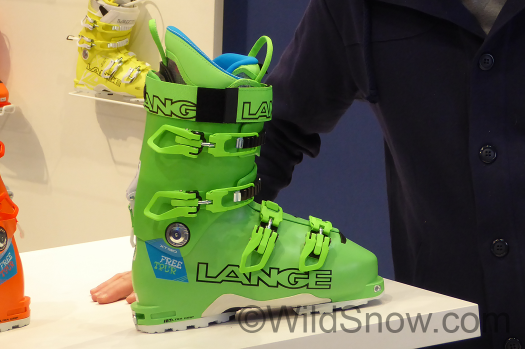
Lange Free Tour, me 2 or me 3? Whatever the case, good example of why the industry needs some kind of standard for the shape of tech compatible ski boots and binding fittings. Up till now, it’s been part guesswork and part copy-cat to come up with boots that work in tech bindings. Result, you never know for sure what boot will work in what binding.
For those of you new to the game, Dynafit has been “certifying” boot inserts for a few years now with a red plastic seal that comes on boots in the box. This new project seeks to go beyond that. If the establishment of a standard is successful, look for an explosion in tech (pintech) compatible bindings and boots — pairings that will work in concert with much fewer issues. (Example of an issue is the boot toe hitting the tech binding front lever and ejecting the user, due to no current industry-agreed standards on binding or boot shapes.)
Where I think you’ll see big changes with Dynafit, for 2016-2017, will be on the ski binding front. Clearly, the Snow Leopard has had a difficult time with his ski bindings over the past couple of years. Beast is not a huge seller — the company’s hope that freeride touring would open a new market has in my opinion not materialized to any significant degree. Fact is, enough people “freeride tour” on wide skis with superlight bindings (including Dynafit employees) as to make beef bindings somewhat of a joke. Sure, if you need them you know who you are, but you are the minority. In terms of binding breakage, problems that appear endemic to a compromised development process seem to come up way too often with the Snow Leopard, example being the breaking Radical 1.0 heel unit. (To be fair, other brands are not immune, but we’re talking about Dynafit here.)
Perhaps the biggest challenge for Dynafit in ski touring bindings? Massive competition that simply did not exist only a few years ago. As I’ve said, this winter of 2015-2016 is when the “binding wars” really commenced. I have no doubt whatsoever the Leopard is feeling the heat. Will the fire be a forge of innovation or a conflagration of disappointment? We think the competition will be good.
To remedy their ski binding durability situation, it’s said Dynafit will instigate a more formalized beta testing program for their bindings. I’m told they’ll pick 100 testers out of the general public, and have those testers attempt to have at least 10 associates also test the bindings. Idea is to get the beta bindings truly field tested. Testopia! Concern is of course the legions of gear bloggers that’ll be panting after getting photos of the bindings as they go out for testing. It’ll be like automobile journalists scamming for images of new model automobiles.
In my view, information about new products gets “accidentally” released so often these days, really, who cares!? I’d say just get the bindings out for testing and don’t look back. A breaking binding is a lot more detrimental to PR than a photo of a prototype. Indeed, having 68 paparazzi chasing around your binding beta testers would do nothing but create awesome buzz! Instead of “chasing the Kardashians,” let’s “keep up with the Dynafits!” (And they can always cloak the bindings with a duct tape shroud, like those new car models.)
Speaking of bindings, a vague rumor I heard is Dynafit may bring back a version of the Vertical series bindings — our clear favorite out of the literally dozens of ski bindings Dynafit has come up with these past years. Wouldn’t it be cool to see a modernized version of the Vertical, instead of what sometimes appears to be over-designed overly-complex machinery? Your prayers are appreciated.
This is where I mention TUV, the for-profit company that certifies ski bindings (among thousands of other things) to DIN/ISO standards. As I’ve alluded to in many other blog posts, TUV certification of ski touring bindings is interesting to bloggers and consumers — if nothing else it’s a marketing tool. Certification is also a way to get “regular” ski shops to sell your bindings due to liability concerns. But I’m not sure a TUV cert is worth the time and expense for most if not all of the involved companies. Or more importantly, I’m not sure adding “features” simply to pass a TUV cert is at all wise. Some of the best tech bindings of the past — and present — do not have a TUV stamp. Again, harken back to the Vertical FT.
So the jury is still out, is the Radical 2.0 any better than the Radical 1.0 (no longer manufactured), even though it is TUV? The 2.0 heel unit appears totally bomber compared to the fragile heel of the 1.0 — but the rotating toe? I’m still formulating my “Lou” take on that. Clearly, due to concerns about breakage of the Radical 1.0 heel, the 2.0 heel is improved, but perhaps the best binding would be a 1.0 toe with a 2.0 heel? It’ll take all winter to figure this stuff out, assuming we don’t run into more fragility problems that steal attention from “normal” testing and blogging (one of the more frustrating things in what we do here at WildSnow).
While in Greece I was sworn to secrecy about Dynafit’s new version 2.0 branding campaign, to be launched at the trade shows. That is now history. The campaign slogan is “Mountopia,” a portmanteau of mountain & utopia. Idea is you go to the mountains to find a sort of nirvana in your encounter with the alpine. (See photo above.) Sure, there is a good dose of hype in this, but the concept has validity and seems more focused than some of the other sport branding “slogan” campaigns we’ve seen over the years. “I am what I am,” for example.
Due to the principle leadership of employees such as Benedikt Böhm and Schorsch Nickaes, as well as umbrella corporation Oberalp owner Heiner Oberrauch, Dynafit really does have a core spirit of substance. I know that because I’ve experienced it in person fairly often for the past nine years. Question is, will a branding campaign such as “Mountopia” dilute or strengthen that core culture, in turn influencing the quality of Dynafit’s products?
To that end (core culture), in concert with Dynafit’s branding campaign Oberalp is attempting a push on their “Corporate Social Responsibility,” otherwise known as CSR. You’re familiar with the concept, perhaps best demonstrated by Patagonia’s sometimes tedious but frequently valid emphasis on environmental causes. At ISPO, Oberalp gave me an 86 page large-format “brand book” based on their CSR program.
Honestly, I had no idea that Oberalp’s CSR was as extensive as it is. I’m somewhat of cynic about this stuff, but I try to be realistic and give credit where credit is due. A good example is the Oberalp (Salewa) HQ building in Italy. I’ve been there a few times and found the climbing wall cute and the “glass cube” look of the building to be stunning. Yet up on the roof they’re harvesting 436,000 KWh of electricity a year — far more than the building uses. That’s real (perhaps a carbon offset for all us ski journalists jetting around the globe?).
Other CSR components that look good to me are Dynafit’s support of the Snow Leopard Trust, and their efforts to reduce possibly harmful chemicals use in their products (a tough issue across the industry, as one reason our modern clothing works so well is a witchy brew of chemicals). I’m also a fan of doing “local” production while possible. To that end, Oberalp does have a goal to manufacture as much product as possible in Europe as opposed to doing things in China. They’re not perfect with that, but it’s interesting to note 100% of Dynafit’s bindings are assembled in Europe, and much of the actual making of the parts is done in the EU as well.
It might interest some of you to know that the spotty issues with quality in Dynafit’s soft goods over the past has been caused (or so I hear) by the company experimenting with different manufacturing locations. From what I’ve seen, quality has been on the upswing and I’d imagine could be acceptable by now, but we need to get out and keep using those zippers and seams before we know for sure.
All the above is fine, but in my view people are what’s most important. The thing to remember about companies such as those under the Oberalp umbrella is they’re operated by real people with real families. People make mistakes and the “corporate” journey to durable functional products is sometimes rough. Yet the core spirit is there — Snow Leopard and his human friends remain worthy.
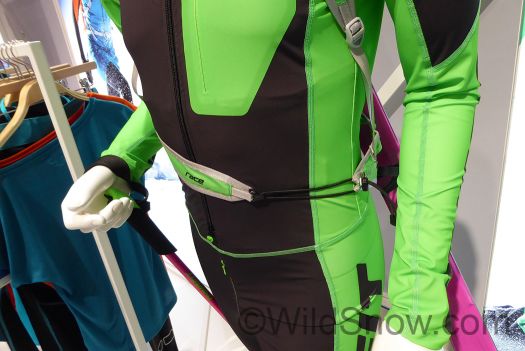
A company such as Dynafit has to innovate or cease to exist. Hopefully consumers benefit from that reality. Imperfect progress is the name of the game. Does a pack waistbelt like this work? I love to see companies trying this sort of stuff.
WildSnow.com publisher emeritus and founder Lou (Louis Dawson) has a 50+ years career in climbing, backcountry skiing and ski mountaineering. He was the first person in history to ski down all 54 Colorado 14,000-foot peaks, has authored numerous books about about backcountry skiing, and has skied from the summit of Denali in Alaska, North America’s highest mountain.

